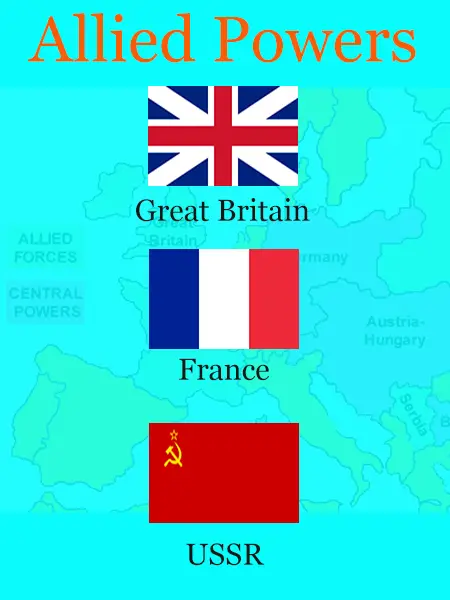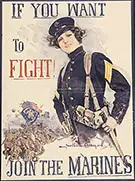Allied Powers

The war was fought between two main groups of countries: the Allied Powers against the Central Powers.
Three countries were the original members of the Allied Powers.
They entered into an agreement in 1907 in part due to their fears of Germany’s growth as a powerful nation.
The three countries were:
- French Third Republic
- British Empire (United Kingdom of Great Britain and Ireland)
- Russian Empire

France
France mobilized 8,000,000 men as part of its war effort.
France called upon colonial support, including the participation of the following countries:
- Indochina – 50, 000 troops
- Madagascar – 46,000 troops
- Algeria – 140,000 troops
- Tunisia – 47,000 troops
- Morocco – 24,300 troops
- West Africa – 16,000 troops

British Empire
Great Britain included armies from England, Scotland and Wales. Including Ireland forces, a total of 4,000,000 personnel were contributed to the war.
The British Empire called upon colonial and dominion support, including from the following countries:
- Australia – 416,800 troops
- New Zealand – 100,000 troops
- Canada – 620,000 troops
- India – 1,500,000 troops
- South Africa – 156,000 troops
- Newfoundland – 8,500 troops

Russian Empire
Many territories of the Russian Empire did not exist as individual countries.
Names of the territories were instead used to describe regions of land.
In total, Russia committed 12,000,000 troops to the war effort.
Leaders
France

Georges Clemenceau was the leader of France, called the Prime Minister, from 1917 to 1920. He helped keep France strong during really hard times in a big war. People called him “The Tiger.”
When the war ended, Clemenceau went to a meeting to make peace and wanted Germany to be punished a lot for the problems they caused.
Britain

David Lloyd George was the leader of Britain, called the Prime Minister, for a big part of the war.
He really wanted Britain to join the war and helped keep the country strong and united while they fought.

During the war, King George V was the king of Britain. Even though he didn’t have much power, he was an important symbol for the people.
He would often visit soldiers on the battlefield to cheer them on and give them hope.
Russia

At the beginning of World War I, Tsar Nicholas II was in charge of Russia. He joined the war to protect Serbia.
Sadly, the war didn’t go well for Russia, and many people in the country were unhappy. In 1917, there was a big event called the Russian Revolution, and Nicholas II lost his power. Sadly, he was killed in 1918.
United States

President Woodrow Wilson was chosen again to be the leader of the United States because he had kept the country out of the war.
But in 1917, he had no other option and decided that America had to fight against Germany.
When the war ended, Wilson thought Germany shouldn’t be punished too much, because he knew that a strong Germany would be good for the whole of Europe.
The Allied Powers included the following countries during the course of the war:
- Belgium – 267,000 troops
- Greece – 230,000 troops
- Italy – 5,615,000 troops
- Japan – 800,000 troops
- Montenegro – 50,000 troops
- Portugal – 65,200 troops
- Romania – 750,000 troops
- Serbia – 707,300 troops
America fought beside the Allied Powers but remained independent. America contributed 4,744,000 troops to the war.
In total, during the war, approximately:
- 5,143,000 Allied Forces died
- 12,801,000 Allied Forces were wounded
- 4,121000 Allied Forces were taken prisoner or missing
Military Commanders
During World War 1 Military Commanders had three main jobs:
Planning
Strategic planning was crucial as they prepared to engage in battle, whether it be attacking their enemy or defending their beloved homeland.
Every move was calculated with precision, considering the most effective utilization of their soldiers, weapons, and resources to secure a victorious win.
The stakes were high, and only those who could think outside the box and strategize with creativity would emerge triumphant.
Leading
The Commanders were the motivators and leaders of their soldiers, guiding them toward a common goal. Like coaches, they orchestrated plans and ensured that everyone was on the same page, working together in perfect harmony.
Their role was to provide direction and ensure that every member of the team knew their responsibilities so that they could work seamlessly as a cohesive unit.
Making Decisions
In the heat of battle, Commanders often face unexpected challenges that require swift strategic pivots.
These situations demand quick thinking and a focus on what’s best for the team, as they adapt to the ever-changing circumstances.
It’s not always easy, but the best Commanders are the ones who can make the tough decisions and steer their troops toward victory, no matter what obstacles lie in their path.
Military Leaders
France

Marshall Ferdinand Foch was a renowned French military strategist who played an instrumental role in World War 1. Born on October 2, 1851, in Tarbes, France, he began his career as a teacher at a military school, where he imparted his knowledge of tactics and strategies to other soldiers.
When World War 1 broke out in 1914, Foch quickly rose to the rank of commander in the French army due to his exceptional leadership and innovative ideas.
He was later promoted to higher positions as the war progressed, owing to his remarkable success in battle.
In 1918, Foch’s tactical prowess earned him the position of Supreme Allied Commander, where he commanded all armies from countries fighting against the enemy. His leadership ensured that everyone worked together as a cohesive unit, ultimately leading to the Allied victory in the war.
Foch’s remarkable leadership and military expertise earned him much respect and admiration. He became a national hero in France and his legacy lives on as one of the most important military leaders in history.
On March 20, 1929, Foch passed away, leaving behind a legacy that will continue to inspire generations to come.
Other notable leaders include Joseph Joffre, Robert Nivelle
Britain

Douglas Haig, a renowned British military leader, was born on June 19, 1861, in Edinburgh, Scotland. He honed his skills at the Royal Military Academy before rising through the ranks due to his exceptional leadership abilities.
As World War 1 began in 1914, Haig was appointed as the commander of the British First Army. His remarkable performance led to his promotion as the commander of the entire British Expeditionary Force in 1916.
Haig’s military prowess was put to test in some of the most significant battles of the war, including the Battle of the Somme and the Battle of Passchendaele.
Despite facing criticism for his tactics during these battles, Haig’s commanding presence eventually led the British army to a victory over the enemy, ultimately ending the war.
Furthermore, Haig’s contributions extended beyond the war itself. After the conflict, he dedicated himself to supporting soldiers and their families affected by the fighting. His selfless service to the nation continued until his death on January 29, 1928.
Today, Douglas Haig is remembered as a significant figure in British military history, whose leadership played a crucial role in shaping the outcome of World War 1.
Other notable leaders include John Jellicoe, Herbert Kitchener
Russia

Aleksey Brusilov was not just any ordinary military leader. Born into a military family, he learned the art of being a soldier from a young age.
Brusilov attended a military academy and quickly rose through the ranks to become a successful officer in the Russian army.
But it was during World War 1 that Brusilov’s brilliance as a military strategist shone. In 1914, he was put in charge of the Russian Eighth Army, and in 1916, he led the famous Brusilov Offensive.
It was a masterstroke that helped the Russian army gain ground and left the enemy reeling in surprise. His smart strategies and tactical skills earned him many accolades and made him a household name.
However, after the revolution, Brusilov’s life took a different turn. He joined the army of the new Soviet government, but he was not as influential as he once was. Despite this, people remember him as a skilled military leader who played a significant role during World War 1.
Aleksey Brusilov will always be remembered for his outstanding contribution to the Brusilov Offensive, which turned the tide of the war and cemented his legacy as one of Russia’s greatest military leaders.
Other notable leaders include Alexander Samsonov, Nikolai Ivanov
United States

General John J. Pershing was a true American hero. Born on September 13, 1860, in Laclede, Missouri, he studied at West Point before beginning his career in the United States Army.
It wasn’t until 1917 that America decided to join the fight in World War 1. General Pershing was chosen to lead the American Expeditionary Forces (AEF) and prepare them for battle alongside other countries fighting against the enemy.
With his strong leadership, General Pershing ensured that his soldiers were well-trained and disciplined. Under his command, the AEF fought in many important battles and played a crucial role in helping other countries achieve victory.
For his contributions, General Pershing became a national hero in the United States and was promoted to the highest rank in the army, General of the Armies.
General Pershing’s legacy lives on as a great American military leader who played a significant part in helping the United States and its allies win World War 1. He passed away on July 15, 1948, but his contribution to the country and military will be forever remembered.
His unwavering dedication to his country and soldiers earned him respect and admiration that has lasted for generations. General Pershing will always be an inspiration to those who follow in his footsteps.



